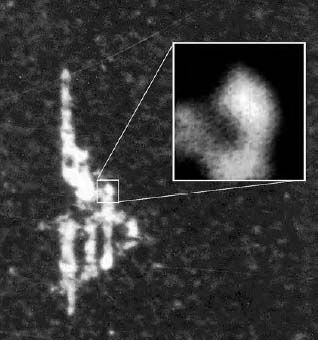Ancient Aliens on the Moon (9 page)
Read Ancient Aliens on the Moon Online
Authors: Mike Bara

The first thing that stands out about this image is a geometric crisscrossing pattern on the surface just northeast of Ukert that seems to defy conventional explanation. One consulting geologist (Dr. Bruce Cornet) even nicknamed the region “L.A. on the Moon” because of its strikingly urban appearance.
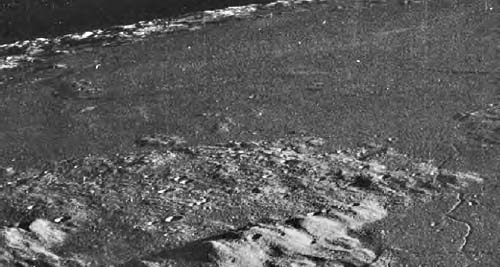
AS10-32-4822 (NASA/Bara).

AS10-32-4822 close-up (NASA/Bara).
In the photograph, over an area of hundreds of square miles (roughly equivalent to the real Los Angeles basin on Earth), there appears a remarkably regular, rectangular, raised, repeating 3D geometric pattern. Large surface grooves stretching for tens of miles appear remarkably similar to streets running across the actual L.A. basin in Southern California. Here and there, small round craters cut into the areas of sharply contrasting, remarkably rectangular relief, like mile-sized cookie cutters. In a close-up from 4822, this rectilinear, artificial block-like pattern, interspersed with a smattering of remarkably uniform impact craters, is even more apparent. Overall, the overwhelming impression is that of finding a vast, ancient, bombed-out city on the Moon.
Even more bizarrely, after ordering the same picture (AS10-32-4822) from seven different NASA archives, it was eventually determined that there were no less than
nine different
versions of the same NASA image, all stacked under the same photo-frame number in the catalog. What this meant is depending on where you ordered your blacked out photo from, you would get a completely different picture, with different lighting and visible detail. What we eventually determined was that these different 4822’s were all part of the same sequence of images taken with a power winder camera as Apollo 10 passed over this region of Sinus Medii. Why this was done became obvious fairly quickly. Putting the various 4822’s side-by-side, some objects (because of the change in the lighting angle) become visible and then disappear. And none of them look like natural objects at all.
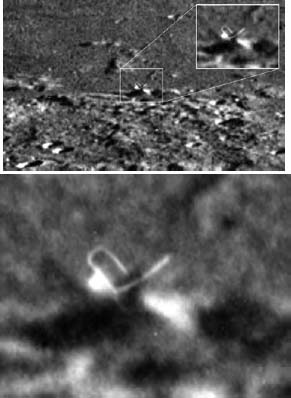
The “Paperclip” (close-up).
Within this general, very artificial-looking land-scape, a series of smaller, very brilliant, horizontal, vertical and near-vertical features also appear. Some are clearly resolved as rectangular structures, others as possible sky-scrapers. Other features are seen as The “Paperclip” (close-up). merely brilliant, geometrically arrayed points of light—possibly specular reflections from surviving optically flat areas similar to windows or entire glass walls.
One of my favorites of these is an object at the edge of the Los Angeles basin I call the “Paperclip.” It has a central post more than a mile high (and which is casting a shadow on the lunar surface) and some obviously metallic antennae which are also casting a shadow in the surface. Whatever this thing is, it isn’t of natural origin.
Later, just before the publication of
Dark Mission
, another researcher named Steve Troy found a new series of images of the Los Angeles area, and what these images showed was even more compelling. One such image (AS 10-31-4652) revealed layer after layer of obviously geometric glass, reflecting the brilliant light of the rising sun almost directly back toward the approaching spacecraft. One can clearly see multiple layers, floors, and innumerable right angle views of what can only be geometrically-arranged manufactured structures. There are even what appear to be suspended walkways and transportation bridges clearly visible.
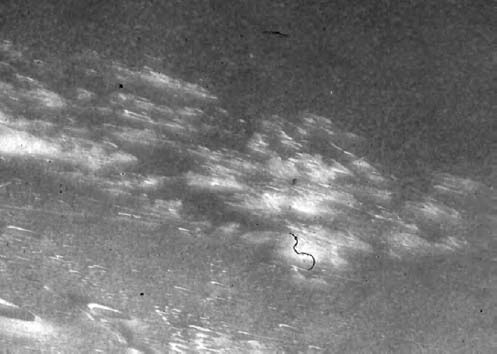
“Los Angeles” at night (NASA AS10-31-4652).
There is simply no plausible explanation for these incredibly reflective, geometrically aligned, transparent structures except an artificial one. But beyond “L.A.,” which was bizarre enough, the real prize of 4822 turned out to be what, at first, appeared to be just a small scratch on the negative.
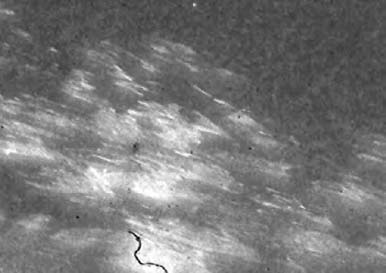
“Los Angeles” at night (NASA AS 10-31-4652) close-up.
The Castle is another glittering, remarkably intact geometric formation first identified on a leaked version of frame 4822 provided by a highly-placed source at NASA’s Goddard Spaceflight Center in 1992. Bearing a striking resemblance to “Schloss Neuschwanstein,” a castle built by King Ludwig II of Bavaria in 1869, (which served as the model for Cinderella’s Castle in Disneyland) it is, in fact, another Ancient Alien artifact hanging high above the Moon.
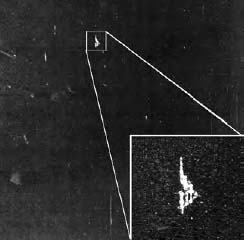
The “Castle.”
The Castle’s location on the lunar landscape is as remarkable as its appearance. As judged by the geometry on frame 4822, this highly anomalous object is actually suspended some
nine miles
above the lunar surface, somewhere between the eighteen-mile diameter crater, Triesnecker and the well-known Hyginus Rille.
Eventually identified on two separate NSSDC versions of 4822, the Castle raised a series of extraordinary puzzles, beginning with the obvious; what is holding it up?
Stereo analysis of these two versions confirmed the Castle’s presence miles above the lunar surface, apparently just hanging out in space. Around it, as previously noted, appeared a collection of much smaller, equally reflective geometric slivers, as if they all were simply fragments of a once much larger, previously intact, somehow suspended structure.
Like the Tower, the Castle too is surrounded by a faint matrix of sparkling geometric, aligned structure. There is also the clear implication of a sagging support cable seen at the very top of this amazing artifact, to which the obviously large and massive structure is physically attached. In other words, the Apollo 10 crew, via 4822, apparently recorded another section (far northeast of the Tower/Shard remains) of this extensive Sinus Medii dome.
Another interesting point about the Castle is that in the original version (above—right), the drooping cable is clearly visible; but in the second version of 4822 (above—left), not only has the cable disappeared with the increased viewing angle, but the entire structure has visibly foreshortened. This is the result of optical parallax, as the Apollo spacecraft moved farther to the west in the few seconds between the two exposures. From this fact alone, there is no doubt that, despite sharing the same frame number, these are two
separate
views of the same object, present on two distinctly different photographic images. And that fact alone makes it a sure fire bet that it is really there, hanging miles above the surface of Sinus Medii.
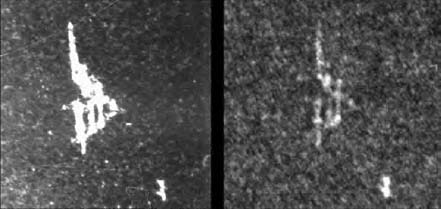
Two distinct views of the “Castle” from two different versions of NASA frame AS10-32-4822. Note the wire passing through the tip of the Castle and sagging under its weight.
